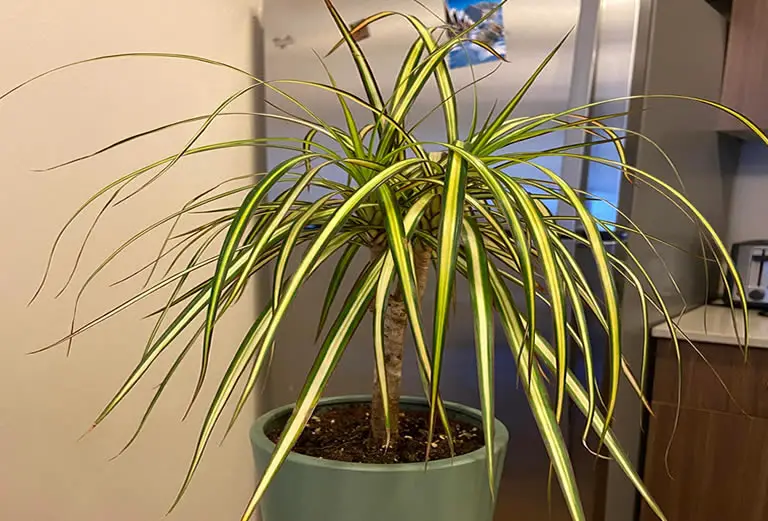There are many different varieties of dracaena that are grown as houseplants and a common complaint I hear from owners is that their plant won’t grow. Dracaena is naturally a slow growing plant but the worst thing any houseplant owner wants is a plant that refuses to get bigger.
In this article I cover the most common reasons for a lack of growth in dracaena and the simple steps you need to take to get your plant back into a healthy growth cycle.
Table of Contents
- Dracaena not growing – 8 problems & their solutions
- 8 Reasons why your dracaena may not be growing
- How to make a dracaena grow
- Give the dracaena the correct light to stimulate growth
- Ensure the correct temperature range around the dracaena is observed
- Create higher humidity levels to increase dracaena growth rate
- Check the dracaena soil is the correct mix
- Get your watering routine correct to avoid stunted dracaena growth
- Add fertilizer to the soil to encourage new growth
- Check your dracaena for disease
- Inspect the rootball of the dracaena for signs of root rot
- A simple trick to get thicker dracaena growth
- How to make dracaena grow faster
Dracaena not growing – 8 problems & their solutions
There are about 120 different species of dracaena consisting of trees, succulent and shrubs.
Although native to Africa and Asia many dracaena species are grown as houseplants in the US, UK, Australia and beyond.
Dracaena belongs to the botanical family Asparagaceae and is an easy-care succulent.
The name dracaena comes from the Greek word “δράκαινα”, with Romanization added to form the name “drakaina”.
Both words are roughly translated to mean “female dragon”.
It will come as no surprise then that a very popular species of dracaena is the dragon tree which obviously gets its colorful name from the Greek-Roman original name for the species.
The majority of the species of dracaena are native to Africa, southern Asia and parts of Australia.
Only two species of dracaena are native to the tropical part of Central America.
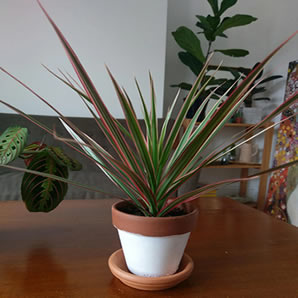
As it is a tropical succulent, dracaena has some specific care needs that must be observed when you grow it as a houseplant.
In almost all cases a lack of growth in a dracaena plant is the direct result of an improper care routine.
So, let’s look at the common reasons for a dracaena not growing so that you can identify the exact cause for your plant’s stunted growth.
But first off I need to address the actual growth rate of the plant.
Doing this will ensure you understand if your plant has actually stopped growing or if you are just not giving it enough time to grow.
Bear in mind dracaena is naturally slow growing
Has your dracaena really stopped growing or is it just growing much slower than you want it to?
Dracaena is a naturally slow growing plant.
It can take several years for a dracaena to fully mature.
In some instances it may take as long as 10 years before the plant reaches its maximum height.
Although dracaena is slow growing there should still be signs of growth from your plant.
Below are the most common reasons for non-growth in this succulent.
8 Reasons why your dracaena may not be growing
I will cover the most common reasons for a lack of growth in dracaena in this section.
There are several possible reasons your dracaena is not growing though the most likely reason is a lack of the correct light.
Dracaena require at least 4 hours of strong indirect light per day to grow.
Here are the most common reasons dracaena do not grow:
- Insufficient light.
- Wrong temperature range.
- Low humidity.
- Incorrect soil.
- Incorrect watering.
- Lack of nutrients.
- Disease.
- The plant is rootbound.
Let’s look at the cures for each of these potential causes, of non-growth in a dracaena, in greater detail. This way you can identify which one is responsible for the lack of growth in your plant.
How to make a dracaena grow
Below I have covered the remedies of the 6 potential causes for lack of growth in dracaena.
I also outline the simple steps you need to take to kick-start the plant into a new growth cycle.
Give the dracaena the correct light to stimulate growth
By far the most common cause for a lack of growth in a dracaena plant, in my experience, is lack of the correct type of light.
Unfortunately, because dracaena can grow in low light conditions many houseplant owners think it is ok to put their plant in a very dim spot that gets very poor light.
This rarely comes without consequences.
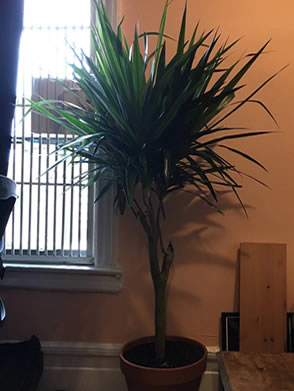
I have found that any dracaena plants that I have grown, or ones that I have tended to, will grow best with a minimum of 6 hours of good strong indirect light per day.
Although you should never give a dracaena direct sunlight, it is best to avoid placing it in very gloomy or overly dim locations.
You can use a grow light for a few hours per day though if your plant must be located in a very dim area.
If all other care requirements are met for this type of succulent then a simple change in the amount and quality of light you give your dracaena plant will almost always result in renewed growth.
Just remember that the plant is naturally a slow grower so don’t expect a massive explosion in growth.
As long as you see signs of new foliage development, you know that you are doing things right, and there is no cause for concern.
Be aware that insufficient light can also result in a dracaena drooping.
Review our article about dracaena light requirements for a more in-depth explanation of the light needs of this succulent.
Ensure the correct temperature range around the dracaena is observed
Dracaena is a tropical succulent that requires warm temperatures to grow.
It grows naturally in environments with temperatures between 65°F – 75°F.
As the average household experiences a consistent temperature range of 70°F – 75°F most modern homes offer an ideal temperature environment for growing these succulents.
If your home is like the average US home then you will have a normal temperature of around 70°F.
However, you must be careful where you place your dracaena as sudden changes in temperature can negatively affect its growth.
Putting your plant beside doors that open to the outside of the house, or beside drafty windows, can cause dips in temperatures in winter or sharp sudden rises in temperature in summer, when the door is opened.
Likewise, placing your plant by heating vents or freezer and refrigerator doors can have a similar effect.
If your plant is in a drafty area or beside a heating vent or radiator move it to a location that gets more consistent temperatures.
Create higher humidity levels to increase dracaena growth rate
Most homes have humidity levels around 30%. When humidity rises above 40% human beings start to feel uncomfortable.
Although dracaena will grow perfectly fine in the low humidity levels of a typical home they prefer high humidity of 40% and above.
If your dracaena is having trouble growing then a boost in humidity will have a very positive effect on the plant.
By using a cheap plant humidifier you can increase the humidity around the plant to a level within its perfect range of 40% – 60% without it having any effect on the overall humidity within the room.
Check the dracaena soil is the correct mix
Dracaena grows in a special type of soil.
Dracaena will not grow well in a standard potting mix. Nor will it grow well in standard succulent soil (though succulent soil is a much better choice than potting mix).
You should aim to give this succulent a soil that performs similarly to succulent soil (fast-draining) but that is also airy and rich in nutrients.
I can’t tell you the amount of times I have discovered dracaena houseplants suffering because they are planted in the incorrect type of soil.
To encourage growth and maintain a healthy dracaena you should mix your own soil with the following constituents:
- 1/2 compost or houseplant potting mix.
- 1/4 perlite or vermiculite.
- 1/4 pumice.
This type of mixture produces a chunky-like soil that is very rich in the nutrients that dracaena need to grow but that is much faster draining than regular compost or potting mixes.
The pumice promotes the much-needed airflow that is missing from most succulent soils but which is essential for the healthy root growth of dracaena.
Get your watering routine correct to avoid stunted dracaena growth
Unlike many other succulents, dracaena is perfectly happy to be watered from the top.
However, just like other succulents you must only water dracaena when the soil has dried out sufficiently.
You will know when a dracaena plant needs watered when the top layer of soil, about 1 and a half inches deep, is completely dry.
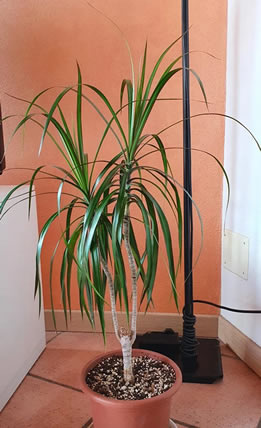
Use a cheap moisture meter to measure the amount of water still in the soil. Push the meter down to about a 1 and half inch level into the soil.
Only water the plant when the moisture reads dry. Alternatively, you can use the finger test.
Why is it important to get the watering routine right for dracaena?
Too little watering will mean the the plant is not getting enough nutrient distribution (water carries nutrients to the outer areas of the plant) as well as dehydrating the outer foliage.
Too much water will usually lead to dracaena root rot and the death of the roots which will not only stop the plant growing but will eventually the dracaena dying.
Most dracaena houseplants will require watering every 2 – 3 weeks. But do not guess.
Check the soil’s moisture level before lifting that watering can!
Add fertilizer to the soil to encourage new growth
Unlike most other succulents it is perfectly fine to regularly fertilize dracaena while it is in its active growth period.
During growing season you can give the plant some fertilizer every 3 weeks to encourage new foliage growth.
If you opt to use a standard houseplant fertilizer then you must dilute it to half strength, as full strength feed of this type will be much too rich for dracaena.
I prefer to use a good quality succulent fertilizer because you can make it up according to the product instructions without having to dilute it.
Check your dracaena for disease
Check your dracaena for signs of disease.
There are several diseases that dracaena are susceptible to. If you find signs of any disease then you must treat them appropriately.
In most cases a good organic fungicide will fix the issue.
Inspect the rootball of the dracaena for signs of root rot
Sometimes the simplest explanations are correct. Have you checked to see if your dracaena is rootbound?
Without room to expand roots become bound up together and can no longer grow.
When roots cannot grow they become unable to sustain a bigger plant.
Bigger roots = a bigger plant.
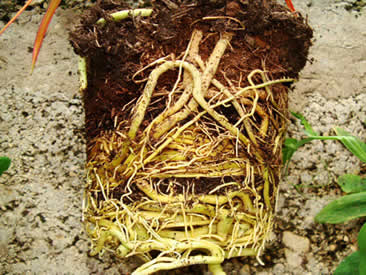
If you find that upon inspection the rootball of your dracaena is rootbound you should do the following:
- Cut off about 1/4 to 1/5 of the bottom of the rootball/compacted soil (depending on how big the plant is).
- Then repot the plant in a bigger container with fresh soil.
A simple trick to get thicker dracaena growth
As I previously mentioned in the article how to make lemon lime dracaena bushier, a great way for encouraging new growth on any dracaena plant is pruning.
Begin by first cutting the tips off the dracaena leaves.
Unfortunately dracaena leaves (at least on plants grown in the US) are prone to developing brown tips due to the chorine and salt content of tap water.
#Hint: use purified water when watering your dracaena and you will avoid brown leaf tips.
Obviously when you remove those unsightly brown leaf tips the plant looks better but by removing them you are also encourages new growth on the plant.
Dracaena tend to become a bit “leggy” as they grow taller and this can greatly diminish the overall pleasing look of the plant.
Pruning away those leggy leaves will greatly improve the overall aesthesis of your dracaena. It also encourages new foliage growth. Over time your plant will look thicker and bushier as well as growing taller.
The video below covers this pruning trick in more detail.
How to make dracaena grow faster
Dracaena is a naturally slow growing succulent so you should not be dismayed by its slow growth rate.
But, I am often asked if there is anything you can do to give this plant a helping hand to make it grow faster.
The key to making a dracaena grow faster is to give it conditions that are similar to its natural habitat.
Ensure the plant is growing in the correct type of soil, with temperatures between 65°F – 75°F.
Give the plant humidity levels over 40% and make sure it gets at least 6 hours of good strong indirect light per day.
Follow the advice given in the earlier sections of this article to ensure you are giving your dracaena the correct care it needs.
What to do when a dracaena lemon lime is not growing
I have covered how to encourage growth in a dracaena lemon lime plant in a previous article. But, as this is such a popular dracaena houseplant I thought I would include information on why yours may not be growing in this article.
Dracaena lemon lime has the same care requirements as other dracaena plants.
So, if you want to encourage new growth on your lemon lime plant be sure to read the sections above and follow the advice given.
To initiate growth in a dracaena lemon lime the plant requires:
- 6 hours of strong indirect light per day.
- Temperatures between 65°F – 75°F.
- High humidity between 40% – 80%.
- The correct type of fast-draining, airy, nutrient-rich soil.
- A proper watering routine.
- Diluted fertilizer every 3 weeks during growing season.
For more details on each of these requirements read the above sections of this article.
How fast you can expect dracaena lemon lime to grow
How fast can you expect your dracaena lemon lime plant to grow?
Dracaena lemon lime grows at a rate of 6″ (15cm) per year.
It is a slow growing succulent that can take up to 10 years to reach full maturity.
If you want to increase the growth rate of your dracaena lemon lime plant be sure to read the rest of this article.
Be aware that if you have pets and want to cultivate dracaena either in your home or in the garden that dracaena is poisonous to some animals. So is the dragon tree (though it and its berries are safe for humans).

